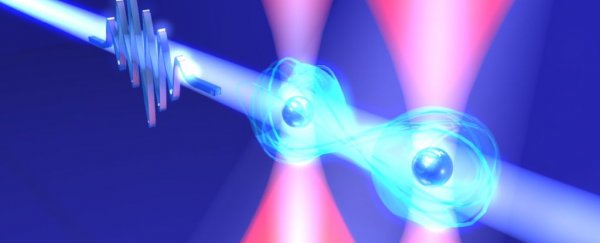Two atoms inflated to an almost comical size and cooled to a fraction above absolute zero have been used to generate a robust, insanely fast two-qubit quantum gate that could help overcome some of quantum computing's persistent challenges.
Since a two-qubit gate is the fundamental building block of efficient quantum computers, this breakthrough has huge implications. It could lead to a new type of quantum computer architecture that breaks through current limitations for noise-free quantum operations.
Qubit is a contraction, short for the term "quantum bit". It is the quantum computing equivalent of a conventional bit – the basic unit of information on which computing technology is based.
To solve a problem the old fashioned way, information (and the logic used to compute it) is represented by a binary system. Like a light switch, the units making up this system are all in an exclusive state of on or off. Or, as they're often described, as a one or zero.
What makes quantum computing so much more powerful is that qubits can be both simultaneously, as a state known as a quantum superposition. On its own, a qubit isn't much of a computer. Combined (or entangled) with the superpositions of other qubits, however, they can represent some seriously powerful algorithms.
The two-qubit gate is a logical operation based on the quantum state of two entangled qubits. It's the simplest component of a quantum computer, allowing qubits to be both entangled and read.
Scientists have been experimenting with quantum gates based on different materials for some time, and have achieved some extraordinary breakthroughs. However, one problem has continued to be significant: the superpositions of the qubits can quickly and easily degrade thanks to external sources becoming entangled as well.
Speeding up the gate is the best way to resolve this issue: since that intrusion is generally slower than a millionth of a second (one microsecond), a quantum gate that is faster than this will be able to "outrun" the noise to produce accurate calculations.
To take a tilt at this goal using a slightly different approach to usual, a team of researchers led by physicist Yeelai Chew of the National Institutes of Natural Sciences in Japan turned to a complicated setup.
The qubits themselves are atoms of the metal rubidium in its gaseous state. Using lasers, these atoms were cooled to almost absolute zero, and positioned at a precise micron-scale distance from each other using optical tweezers – laser beams that can be used to manipulate atomic-scale objects.
Then, the physicists pulsed the atoms with lasers. This knocked electrons from the closest orbital distance to each of the atomic nuclei into a very wide orbital separation, puffing the atoms up into objects known as Rydberg atoms. This produced a 6.5-nanosecond periodic exchange of orbital shape and electron energy between the now huge atoms.
Using more laser pulses, the research team was able to perform a quantum gate operation between the two of the atoms. The speed of that operation was 6.5 billionths of a second (nanoseconds) – over 100 times faster than any previous experiments with Rydberg atoms, the researchers said, which sets a new record for quantum gates based on this particular kind of technology.
That's not quite beating the overall record for the fastest two-qubit quantum gate operations yet. That was achieved in 2019, using phosphorus atoms in silicon, achieving a mind-blowing 0.8 nanoseconds; but the new work involves a different approach that could sidestep some of the limitations of other types currently in development.
In addition, exploring different architectures could lead to clues that help minimize deficiencies in other types of hardware.
The next steps, the team said, are fairly clear. They need to replace the commercial laser with one purpose-built, in order to improve accuracy, since the laser can contribute to noise; and implement better control techniques.
The research has been published in Nature Photonics.
